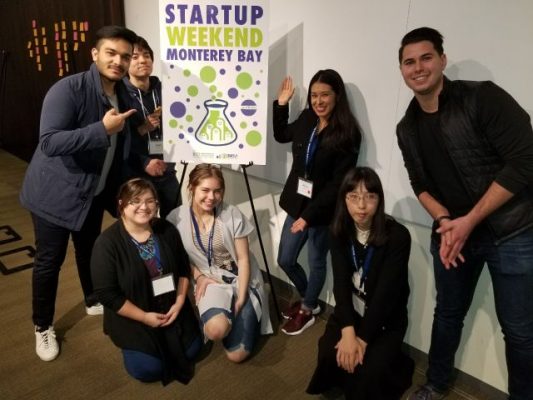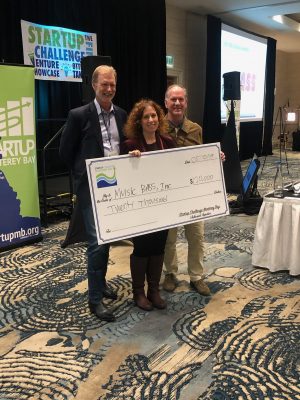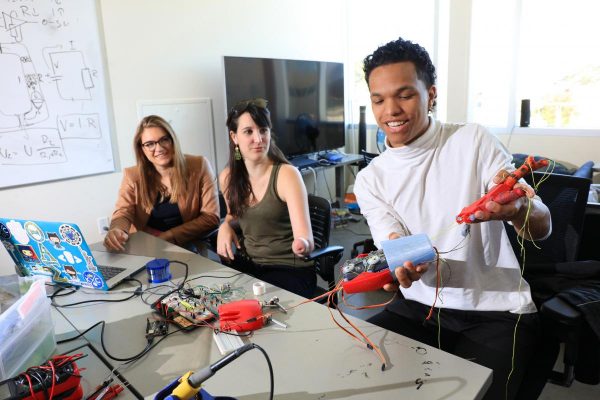Events
Content is Queen: lynda.com Founders Tell Their Story
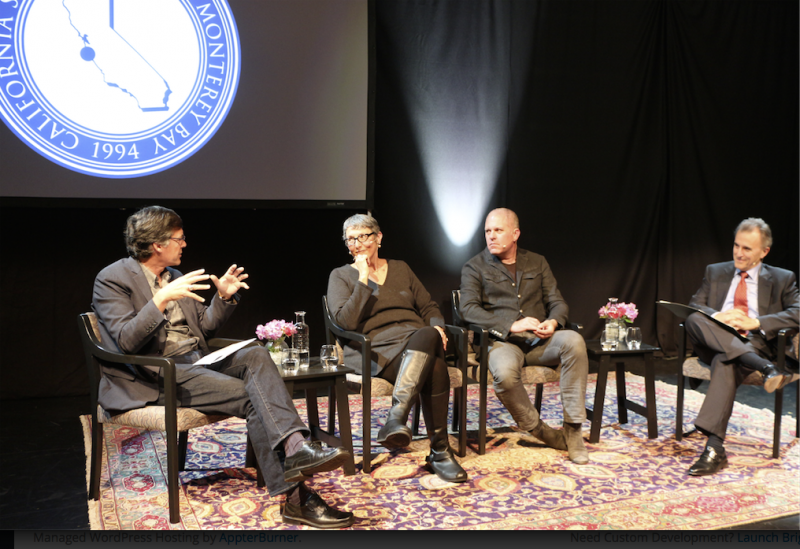
By Jan Janes
Special to Santa Cruz Tech Beat
(Photo above: Left to right, Bud Colligan, lynda.com co-founders Lynda Weinman and Bruce Heavin, and CSUMB President Eduardo Ochoa answer questions from the audience after the co-founders presented the lynda.com story at the new Colligan Theater in Santa Cruz. Credit: Jan Janes Media)
December 6, 2015 — Santa Cruz, CA
The lynda.com Story: From Bootstrapping Start-up to Leader in Online Learning

CSUMB President Eduardo Ochoa welcomed the audience to the new Colligan Theater. (Credit: Jan Janes Media)
Lynda Weinman and Bruce Heavin shared their passion, start up challenges and success stories during a lively presentation at the Colligan Theater in Santa Cruz and by live link to faculty, staff and students at California State University Monterey Bay (CSUMB) on December 2.
From Bootstrapping Start-up to Leader in Online Learning, the final fall event of the President’s Speaker Series for 2015 introduced by CSUMB President Eduardo Ochoa, traced the evolution of the lynda.com company from Ojai, California to its $1.5B acquisition by LinkedIn earlier this year.
“It is a remarkable high tech success story,” said Ochoa, “and we are delighted to have the two people responsible for it here to talk with us today.”
Things Done “Wrong,” At Least On Paper
From the outside looking in, according Heavin, they did a number of things that should have negatively impacted the company’s success. A married couple, they started the business in idyllic Ojai, population 8,000 and miles away from technology and urban hubs. They had backgrounds in teaching and illustration, no business plan, no MBAs, not even a business school class.
“I had written a book on web design for mere mortals that became a bestseller,” said Weinman, “and I was being asked to speak and teach all over the country, the world.”
A desire to decrease the travel led to the question: Would people come to her instead?
“We didn’t have ambitious goals,” Weinman said. “We just wanted to make a living doing what we wanted to do.”
Following Their Passion, Managing Brand and Identity
Weinman wanted to teach, Heavin wanted to draw.
The domain lynda.com became the portal, which Weinman dubbed the sandbox for learning web design and marketing the first book. She wrote the book in a user-friendly style for students who needed to understand web terminology in non-technical ways. Heavin suggested finding a physical classroom, which they rented from a high school during spring break. They advertised these early web design classes, which filled with people from all over the country.
“We did this as a way to test,” said Weinman. Funded with $20K in royalties from the web design book, they continued to offer classes and workshops in physical schools. Magazine articles and public speaking events generated word of mouth that fueled their expansion.
With fully booked classes, the partners recognized the next tool to deliver the learning was in video, specifically VHS tapes. Their research revealed their competition investing a lot of emphasis on production value with delivery, jokes, animation and embellishment. But as a result, the competition was slow to market, as much as eight months late.
So we said, “Good enough and fast to market,” according to Heavin, resulting in lynda.com sales of training tapes shipping out to customers in a week or two, with much less digital editing.
Weinman also revealed that she wanted to be the only teacher and to control everything. When you are used to writing, designing your own curriculum and handouts, “The hardest thing was learning to delegate,” she said. Other early challenges were times when they had to override ideas and decisions from people brought in to manage, but did not share the founders’ vision.
Scaling the company required teaching more topics than web design and expanding the location beyond the confines of a physical classroom.
It did not include taking money from larger corporations.
Profitability Protects Creative Freedom
The initial $20K book royalty seed money grew the company to $1.7M first year revenue, $3.5M fourth year revenue, and approximately $10M revenue at the ten year mark. Those income levels, and the awareness that lynda.com had been profitable from the beginning, attracted outside investors.
“We decided to reject their offers,” said Weinman. The company already had enough money, and the founders recognized and appreciated their creative freedom and didn’t want to give it up.
The company moved from Ojai to Ventura, and finally to Carpinteria, to attract and accommodate a growing staff and facilities. “We had to keep changing our location for talent,” said Heavin, “and every time we found a new location and did a build out, by the time we moved,” the company had outgrown the new facility.
A Shift in Delivery Impacts Revenue
In 2002, lynda.com moved video instruction online and began generating revenue using a subscription model. Pricing the service at $25 per month, a price that has not changed, the founders used the two benchmarks of what a college student could afford out of pocket, and the cost of textbooks at that time.
“Gut. Very low tech,” said Weinman. “This is the price based on the little bit of feedback from two groups.”
Customers loved it, but the online service precipitated the collapse of the video business. A four-year struggle to make ends meet ensued, though ultimately the subscription service grew to surpass the video revenue. In simple terms, the company had to subscribe six new customers at $25 per month to make up for one lost video sale of $150.
Management changed the business structure to maintain revenue streams through book sales, classroom teaching and conferences. “The focus was always around education,” said Heavin, attributing income from those sources that sustained the company as the video business faded out.
Scaling Up
The founders and company employees wrote more than 15 books, attracted contributors to create and teach, and adopted a royalty business model from the publishing world. Often in the online world, contributors receive no pay. Paying early and well helped recruit and retain knowledge experts. The company developed a reputation as industry insiders in online education.
Moving to the internet and away from the physical classroom shifted the delivery model to one to millions, not one to 20. A request from a teacher, explaining that, with a few forms and some admin access, she could sell it to her school district, opened up new channels. As an enterprise business, lynda.com has been adopted by 40% of the colleges and universities throughout the US.
“This was a really significant part of our business we had not thought of before,” said Weinman, “but was requested from the outside.”
Additional growth resulted from adding new teaching categories that attracted entirely new audiences. The company’s initial instruction focus in web design and photography expanded into business skills, programming languages and other areas, driven by response to customer requests..
According to Weinman, taking evolutionary steps to grow the company from classroom training, with revenue streams in book publishing, consulting work and conferences, allowed the company to grow at a predictable, steady clip. In 2006, the focus shifted 100% to the online subscription service.
In another shift, the company moved from purely B2C to B2B. “We were working directly with our customers, one on one. Not with large corporations,” said Heavin. “Neither of us had sales expertise, so bringing on a sales team took a while to develop.”
lynda.com – Where Content Is Queen
Increased revenues created the opportunity to improve production values and develop an expanded library of information. “In the beginning it was very scrappy,” said Weinman. “And our materials are really easy to understand.”
“We asked, why would people stay subscribed?” said Heavin. “And our answer was, we have to build out to make this compelling offer.” By providing fresh content, people learned new things and stayed curious.
The teaching style is designed to be friendly, approachable, contextual and explanatory. It has been honed into a branded pedagogy that differentiates lynda.com from other training companies. New instructors, hundreds of them, deliver high quality learning materials in understandable bites. Video trainers team up with producers who listen to the instruction and offer feedback, questions and clarity.
MOOC Competition Leads to Outside Investors
After 18 years, lynda.com accepted its first round of funding. “I didn’t ever want to take on money,” said Heavin. “We were growing. I was very happy with what we were doing. I saw it as a mission to help people.”
“By waiting,” said Weinman, “our valuation dramatically increased.” The company had been profitable from the beginning and had achieved industry leader status.
In 2013, MOOCs were in the news in a really big way, getting massive press, talking about revolutionizing education.
“We were quietly humming along with millions of people paying for our service,” said Weinman. It was hoped, by taking on the investment, the company could hire more people and generate more press. But the business press focused on funding, and not the success stories of the individuals using the service. By taking on investors, top advisors from world class companies joined the board of directors.
“And Bud Colligan!” said Weinman. “To the audience sitting in the Colligan Theater, Bud was not an investor, but he was on our board of directors, our first board member.”
We Were Not For Sale
The call from LinkedIn was a surprise. Nobody was brokering a deal.
“It was totally out of left field,” said Weinman, “but it really made sense to us.” LinkedIn has the largest database of job seekers in the world.
“We saw we could make the kind of impact we had always dreamed of,” she said. The company could grow from a few million members to a potential audience of more than 400 million.
Lessons Learned on the Way to Success
- People didn’t believe in what we were doing. Heavin recalled sharing the business model and charging for subscriptions with business evangelist Guy Kawasaki, who told him that no one would ever pay, it should be free. Recently Kawasaki recorded a course on lynda.com.
- Always be ready to change hats. In the beginning, Weinman said they would have to do one thing to get to a certain point, then change to get to the next point, then change again. Do anything and everything to stay afloat, focus on where the company is really strong and really different.
- Follow your passion. Weinman loves to teach and rocks at web design. Heavin loves photography, illustration and design. In the beginning, there were no thoughts about becoming a multimillion dollar business, nothing remotely close. They kept their focus on the areas they were drawn to.
- If you’re going to charge, be better than free. One of the ways they knew they were the best, Weinman said to audience laughter, is their educational content was always at the top on the pirate sites.
- Be better than downloading loose movies. What’s the navigation, the UI/UX? How can a user track the learning experience? How can the player be better?
- Treat everybody really well. Lots of companies cut corners. Or don’t treat their customers right. Or don’t treat their employees as well as they could. Treating everyone well is a strategy to success and amazing employee retention.
- Experiment with low risk ways to test ideas. In the beginning, lynda.com didn’t have a big idea, go looking for funding, have a business plan, or do a bunch of research. They tested ideas in low-risk, iterative ways. It showed what would work, and what wouldn’t.
- Leverage what you love. Your expertise, your connections. your passions. Start with who you know, work with them, build your own network.
- Content is queen. Content is king is the popular saying, but this company had a female founder at the helm. Even when the website was poor and the video quality rough, content is queen. And lynda.com’s content is teaching. Which is why people came, and people stayed.
- Work to be profitable. Find a way to bootstrap your business, be scrappy, learn how to run the finances. Have a product that people will pay for.
- Be a very long term thinker. Explore how to be profitable, then reinvest that profit to make the company bigger and its people better.
- Do things on the cheap. Do the very best you can with the tools you have. Don’t let the inability to have the best stop you from proceeding with your plans.
When Your Business Partner Is Your Spouse
Both lynda.com founders were frank in describing the extra challenges that show up when working with your spouse. Both said they were strong, critical, demanding.
“There was a time when we would work at opposite ends of the hallway,” said Weinman, “and lots of times where we disagreed. I’m really glad I had a partner who had this unabashed ability to challenge my ideas.”
When the company was small, Heavin said, “We stepped on each other’s toes all the time. Later on we eventually did run different areas, and there was a little separation.” But, he cautioned, the person you’re working with is the same one you go home to. Make sure you’re going to have a good evening, a good weekend.
In the end, according to Weinman, “We have something really magical and really special that we got to build together.”
A View on Where Learning Is Today
Weinman closed out the first part of the presentation sharing her concerns about the state of education today. Demand is growing and new institutions are not being built. A college diploma is not a ticket to employment, which was a promise made to students who worked hard and followed the rules. She said that there is more student debt than credit card debt in the US.
Students consume more than ten hours of digital media daily, resulting in a completely new generation of learners. “Today, a lot of teachers are new to technology, and kids have been born with a mouse in their hands.”
There is research that online interaction is rewiring our brains. Schools are emphasizing test results over education and learning.
“Education is a tarnished brand,” Weinman would tell lynda.com staff. “But learning is pristine.”
Online learning can benefit from in-person learning, where lecture, audiovisual and animation materials are supported with discussions, practice by doing and teaching others. The essential skills of working collaboratively with others, managing disagreements, selling ideas and being able to handle feedback and failure are learned by doing.
“I really believe a combination of online and in person is the future of learning,” she said.
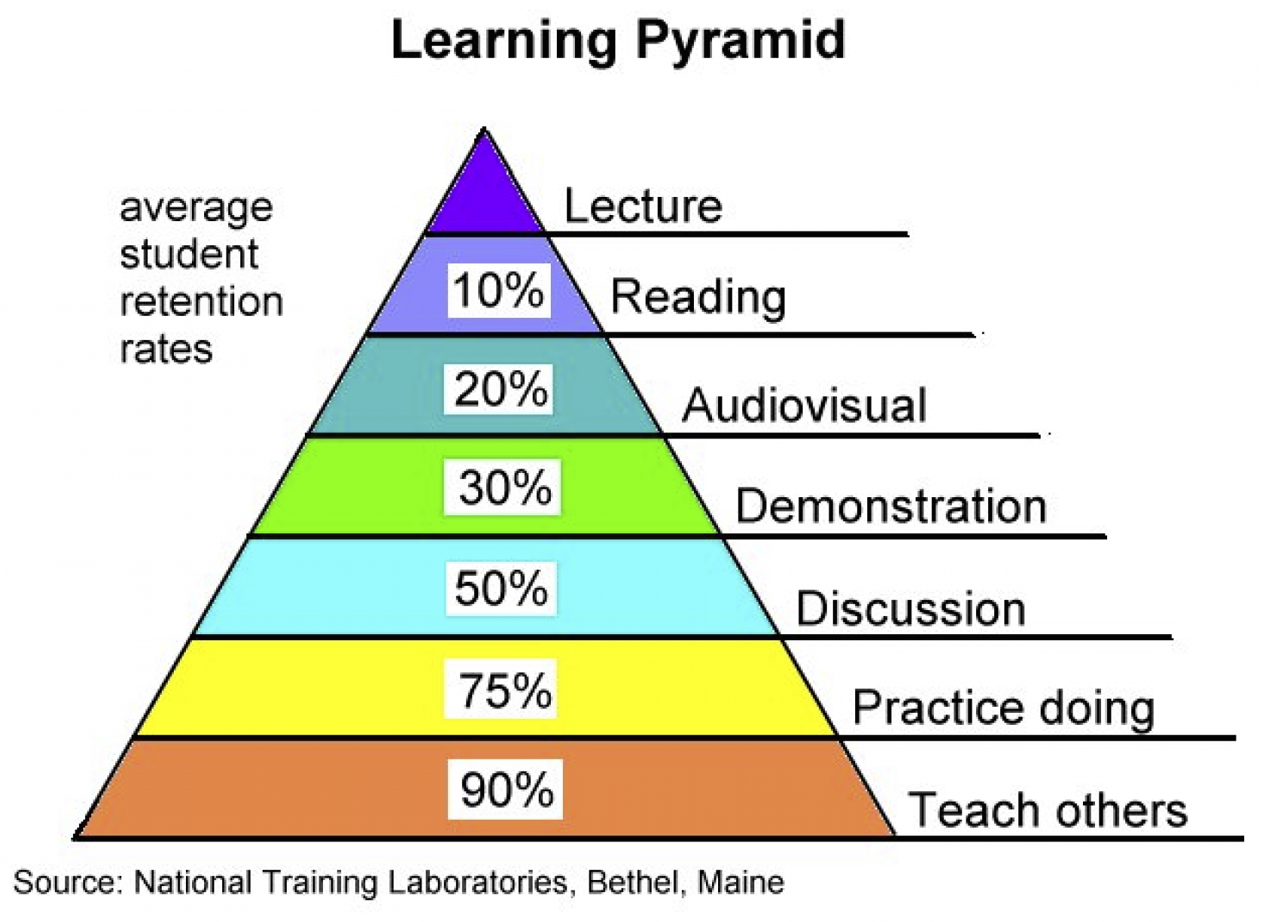
Weinman referenced the learning pyramid developed in the 1950s, used to illustrate teaching methods impacting student learning and retention. She emphasized that much of teaching/learning today should still be in-person, despite excellent online learning tools.
Joint Audiences Bring Their Questions
Immediately following their presentation, Weinman and Heavin answered questions from audiences at CSUMB’s World Theater and the Colligan Theater.
What advice do you have for students who want to become entrepreneurs?
Heavin: What are your passions? My own experience is that we’ve evolved this around our passions, not a business idea. The business idea came through our passions. There’s nothing better than when you love what you do.
Weinman: Another aspect is to test things in a low risk way. Make sure ideas have an audience, that you’re really the right person to do it, that you have a market, that you are somehow different, or better, or can add some kind of value that others aren’t adding.
At what point did you hire people to take care of systems and stuff? What part of the business do you let other people own?
Weinman: We were in a fortunate position to do the things we loved and were good at. They were different things, we conquered and divided our areas. We did hire people right away and were extremely fortunate that our idea took off right way. In the beginning when the organization was very flat, under 30 people, you don’t really need managers. As we grew we had to learn a lot of that, which is not that difficult to learn. It was clear from the very beginning we couldn’t do everything ourselves because the demand of what we were doing was so huge.
What was the evolution with the purchase from LinkedIn?
Weinman: The acquisition came very suddenly, unexpectedly and quickly. It was done in under 60 days. That was really hard. We weren’t ready to be done with the company in that short a period of time. But for all the reasons I’ve shared, I think it’s such a great fit. We’ll go on and do some other great stuff. Meanwhile we get to take a break after 20 years.
How did you qualify your instructors?
Heavin: A couple of different aspects. We have Lynda and I as experts and curators. I will contact people in illustration and design, people we know in the field. We also learned something from Art Center College of Design, a progressive idea from the 1930s, that you don’t hire teachers, you hire working professionals. People who do this day in and day out, and know it well. A working professional knows how it works in the real world, not theoretically. Those, to me, made the best teachers. Because watching them work was far more interesting.
How did you decide to incorporate softer skills into course offerings?
Weinman: That was customer demand. We started off with web design and motion graphics, that was me, photography and illustration, that was Bruce. We started getting phone calls: would you offer this, would you offer that? It became clear that people wanted instruction in so many more things than we were offering. Even to this day, lynda.com would have capacity to teach far more than we do. It’s really because those things are needed, and the video media is a great way to impart the knowledge.
Colligan: Over the last five years it was about the areas Bruce and Lynda talked about. But then there were adjacencies. If you’re doing web design, you start to get more complicated programming needs in developing more sophisticated web designs. That led to a whole strain of program courses the company did. On the soft skill side, people started saying where are the sales skills, negotiating skills, marketing, search engine optimization. Business functional areas started being built out as well, and productivity areas, project management, using Google docs. It was like an amoeba that kept expanding by the adjacencies and what customers asked for. When you go to the enterprise accounts, they were interested in the kit and caboodle, from HR to all the functional areas.
Heavin: There was a thought process on our part, that we should be teaching all the stuff we need to operate our company. Our marketing, graphics, video, business, finance. We should be teaching the DNA of what our company is to the world.
With B2B enterprise, specifically relationships and universities, how does that work? How do they use lynda.com?
Weinman: It was a very important relationship because I shared how strongly I feel about in-person education. I saw, with the MOOCs getting so much publicity, they were stating you can have the same experience you’re having in person, but online. They tried to replicate in-person learning. lynda.com was a complement to in-person learning, not in competition with it. For example, at the USC film school, the teachers no longer had to teach the software of film editing. They could focus on storytelling, or on the craft, or on the student’s particular project. lynda.com could cover the software part of it, freeing the teacher from certain rote instruction to offer more high touch time.
Heavin: As software keeps updating, on average in 18 month cycles, with a few new versions of Photoshop, guess what: That feature has been moved, it’s been improved, or it’s been replaced. Where did it go? We were the constant source for people to go to get that information. The skills behind it that colleges teach, the ideas, principles and concepts, the students will work with their entire careers.
What did you do with all the data you were collecting on all these people, the demographics, the age, the gender, the course progression? Was there a moment in time when you realized you were sitting on this goldmine of all this great data that you could mine and use to market, up sell, to do some really interesting things?
Weinman: Actually, we didn’t collect any of that data you just said.
Heavin: That goldmine, we actually know all the data, we would never want to hold it. Maybe we might have wanted it for marketing. but we weren’t in that business. That was not our business. We were not in the business of passing information to software companies or others for marketing. We didn’t run any advertising. We really valued our customers.
One of my biggest fears is giving to a large company and not having creative freedom. How did you keep that freedom?
Weinman: It’s a great question. We were able to keep our creative freedom by being successful. There’s no other way to describe it. We were able to make a profit, we were able to pay our people, we were able to grow our company, and we got to do that on our terms because it worked. Had it not worked, we wouldn’t have been able to.
Heavin: You know, as a designer, you have to check the ego at the door sometimes, and it’s not about you. You have to have your own venues for your own creativity. If your job doesn’t fit that bill, you’ve got to find that venue for it. Because it’s really hard, it’s not about you. And you need to find something that is about you, and what you enjoy in life.
President Ochoa, do you have professors of practice at CSUMB, where you bring in practitioners, professors of practice?
Ochoa: All of us use adjunct faculty. It provides us with flexibility in terms of ups and downs in enrollments without affecting tenure track faculty’s job security. The other great benefit of having adjunct faculty is precisely that. The ideal profile for adjunct faculty is somebody who has a day job as a practitioner in their areas, and is doing this mostly because they are interested in teaching what they know. It’s a win-win situation. It works very well in many of our professional programs.
Out of love and drive, you have spent the past 20 years creating something you could never have imagined at that time. You’ve both said you’re mulling things in your minds, so I’m curious as to the process you’re going through right now, looking forward.
Weinman: When we were on vacation last year, we watched this movie about chess. I looked up the child prodigy talked about in the film, and he had written a book about how to be successful. He said the reason he was successful at chess was because his dad let him play. The other chess champions were being drilled all the time, they were never allowed to stop. Sometimes I think your best ideas come when you’re not expecting them to come, and you’re not forcing them. I’m trying to be really open in this unusual experience, after going at something so hard for 20 years. Just being really open to serendipity, what comes, and what feels right, and it’s very intuitive. We still have a lot of talent between us, and passion between us, and we’re not just going to fade away.
Heavin: I tell Lynda I have a good business idea every other week, or I have an old one. About a week later: No! that’s a lot of work. Do I really need to do that? There’s something there, we just don’t know what it is.

Patrons enjoyed a reception in the courtyard outside the Colligan Theater after the presentation. (Credit: Jan Janes Media)
###
Jan Janes, Communications Director, Web Publisher, Television & Radio Producer, Photojournalist, Social Media Architect, can be reached on LinkedIn.
###
If you wish to republish this article, please follow our Terms of Use.
###
Tagged Bud Colligan, CSUMB, lynda.com





